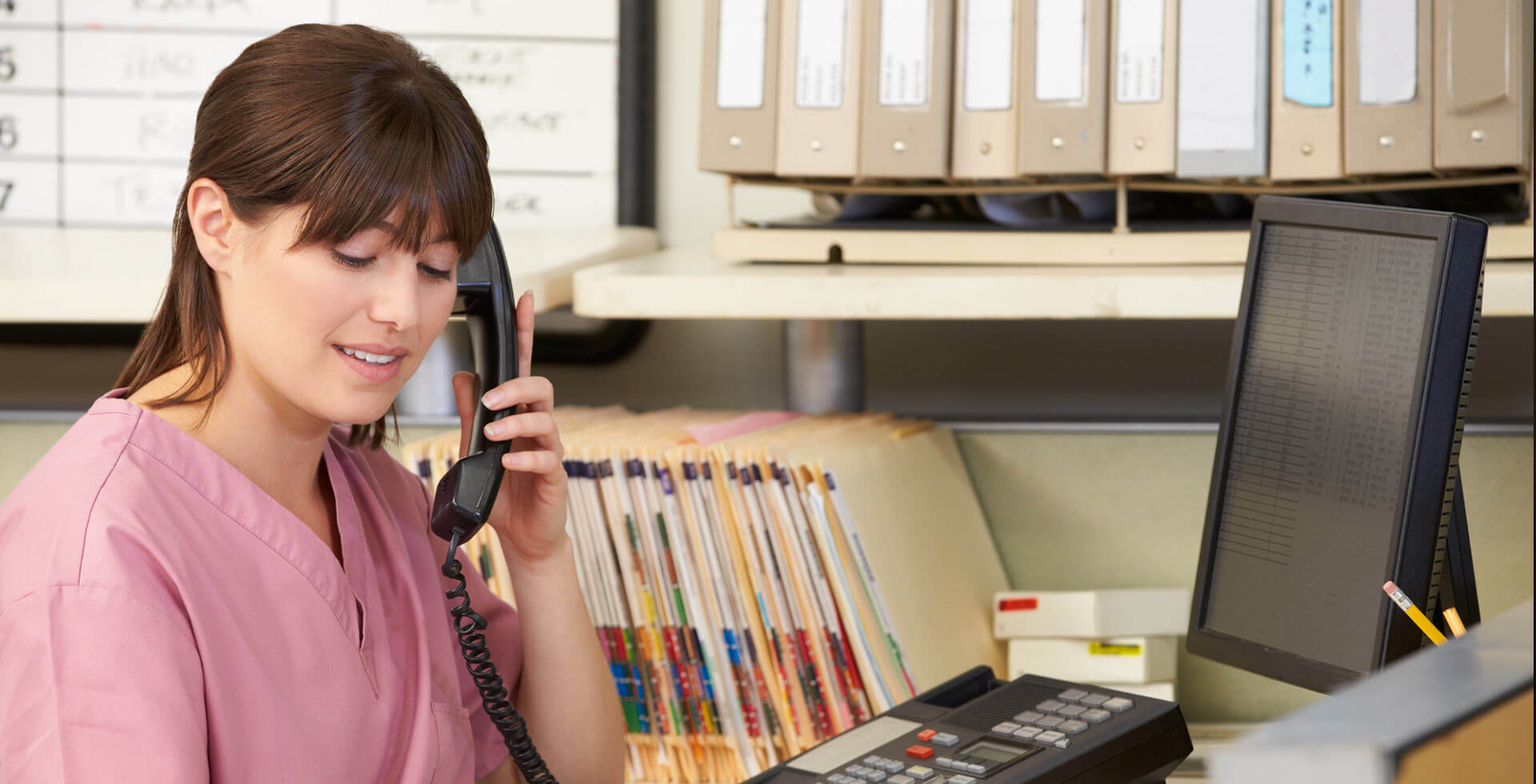
Nursing Telehealth Triage has become increasingly important as a way to improve the healthcare process and overall patient satisfaction. Nursing Telehealth Triage is currently one of the most utilized entry points for clinical care in the 2021 continuum of care. COVID put telehealth front and center as the solution for patient care, but for thousands of virtual care nurses it was business as usual.
This approach is not without its challenges as nurses are asked to adapt their knowledge and skills to a less personal interaction with patients. Though telephone and online channels can be a very efficient tools to streamlining medical care, they also limit your access to the patient. You can’t see, smell, or touch the individual and must rely on the information you can draw from the person on the other end of the phone.
Let’s discuss a few suggestions for how to best connect with the callers in an effort to provide clinical care that is equal to if not better than that received in person.
Being an effective Communicator is an essential skill that is often overlooked when hiring triage nurses. Sending messages that are received as intended is imperative when practicing virtually. This essay offers some helpful tips for any clinicians involved in telehealth.
LINK TO -- Triage Nursing Won’t Play Second Fiddle to Telemedicine
First, establish therapeutic rapport in two steps
Show the confidence to be the solution
If you walked into a car dealership and the salesperson loped over to you dressed in a baggy suit, avoided eye contact, barely spoke above a whisper, and slouched, how would you feel about purchasing a car?
While your patients cannot see your posture or attire, confidence can be heard in your tone of voice or relayed in your word choice. A lack of confidence is anything that indicates “I can’t help you,” or “I can’t do anymore for you.”
Therapeutic rapport is about building trust. The first step of trust is a confidence rooted in your capabilities to help the patient.

Projecting Confidence Over the Phone:
- Let your patient know that you’re going to do everything you can to help him or her.
- Use body movements to help you feel more confident (stand up, put your hands on your hips, stretch your arms out, lean forward, etc.)
- Monitor your tone of voice, speak evenly and clearly
Copy that, I understand
Last time I called my internet provider, I started by telling them I’d reset my router and modem but my internet still wasn’t working. I had a deadline to submit a report and needed fast service. You can imagine my frustration when the representative blandly said he would help me, collected my account information, and then asked me to reset my router and modem. Not only was there no urgency his demeanor, the representative clearly did not hear anything I had said.
Understanding and sympathy is key to communication. You offer the caller reassurance and clarify that you understand what he or she relayed. Military protocol always requires at least a “Roger” to indicate the message was received. It is crucial that you acknowledge the problem and offer some sign of empathy.
Summarize what you heard. If they’re emotional, start with an empathy phrase:
- This must be difficult for you….
- You are obviously having a tough time….
- I know you’re upset….
- I’d like to help you if I can.
- I understand this can be frustrating….
- I know this process can be confusing…
Follow your gut AND your logic
Sometimes patients may not understand the severity of their situation or they may be focused on the wrong details. Sometimes they have a hard time communicating what’s really going on. Do you remember the story about the abused woman who dialed 9-1-1 and ordered a pizza to notify the police her life was in danger? What if that officer had discounted her as a prank caller and disconnected the call before understanding why she was really calling?
You need to pay attention to queues and follow your gut. Trust your experience and your training to guide you toward the correct nursing assessment. It took years and a lot of money after all! It’s not necessarily in the best interest of the patient to hand him or her off to the next level of care until you’ve gained all of the information you need, even if it seems cut and dry. Take the extra few minutes to pull up the patient’s medical record and ask the pertinent questions because it can save precious time in the long run. Remember, some patients understand their conditions better than others. Those with chronic medical conditions may be able to communicate in a more educated manner because it is a part of their everyday lives. Not all callers operate on that same level so it is imperative that you consider the caller’s level of understanding and word your responses accordingly.
With that in mind, also use your brain. If you end up with a call outside of your comfort zone, approach it as logically as possible but don’t ignore your instincts. For example, maybe you have little or no mental health experience but you are dealing with a caller who is seeking immediate treatment for depression. Before disconnecting the call and/or handing the caller off to the next level of care, take the time to make sure the patient is safe just as you would any other crisis call.
Protocols are imperative
Protocols are in place for a reason. Passengers on a plane would be frightened if their pilot suddenly abandoned the safety checklist for their flight. Patients should similarly worry if their nurses stopped adhering to protocols and clinical decision support. Protocols are necessary because they:
- Protect against repetition fatigue and help you stay fresh to catch those critical care cases.
- Improve safety of the patients.
- Help avoid stereotyping.
- Free the nurse to listen instead of remember the complex medical guidelines and be engaged in the call.
- Help educate newer employees who have the medical knowledge but need to remember all of the company’s guidelines.
- Help ensure that the required steps are followed for every call.
Proper use of protocols is to ask the patient general questions, and select the relevant protocol choice yourself. For example, instead of asking 5 protocol questions about the wound site, ask the patient to describe the wound site. Some protocols will ask about the patient’s temperature many different times. Simply ask the patients’ temperature once and choose the appropriate protocol answer yourself.
Don’t be a robot
You’re not a robot, and your patients don’t want to speak with somebody reading from a protocol checklist. We see far too many nurses turn off their brain and their training, and use the protocol as their only guide.

Just as pilots don’t learn to fly from a safety checklist, nurses don’t learn triage by reading protocols.
Protocols and checklists are problematic for a number of reasons. They tend to utilize close-ended questions, avoid gathering situational information that could be relevant, and ignore the caller’s expectations. Checklists have a place in telephone triage but tend to be most effective when used as a safety-net for expert users already knowledgeable about clinical content. Instead, practice the following interview techniques:
Channel your inner Oprah
That woman can give an interview and so can you. She rolls with the feel of the interview but never loses control of it. She's very present in the interview.
When you’re on a call, keep control but pay attention to what your caller is trying to tell you. Take note of strange speech patterns, bizarre comments, and outlying information that doesn’t fit with the rest of the patient’s medical record. Find out where the patient is. How accessible is emergency medical treatment or urgent care? Is the patient alone? Is the patient safe? Does the patient have access to transportation if the situation changes? Are there language or intellectual barriers?
Turn your frown upside down
Think back to the last frustrating interaction you’ve had with a customer service representative. Compare it to the last time somebody gave you incredible news over the phone. How did each person sound? How did these phone calls differ?
| Smiling seems simple but sometimes it can be difficult. When you smile on a phone call, your voice just sounds warmer, friendlier, and more receptive to your caller’s plight. This may be a lot to ask for at the end of a long day or when dealing with a less than cooperative patient, but that may be when you need it the most. Need a little reminder to smile? |  |
Our Practical Suggestions:
- Hang a small mirror in your line of sight
- Tack up a comic that always makes you grin.
- Keep smiling pictures of loved ones on your desk
Your patient will appreciate the extra effort.
Going in blind
Obviously, nursing assessment, diagnosis, and disposition are handled entirely different over the phone than in person. When working with patients via telephone, you must rely far more on the person on the other end than your own senses and that can complicate things a good deal. It may help to visualize the steps you would follow for an in-person assessment and ask corresponding questions in layman’s terms. It can be challenging to obtain the information you need from an untrained individual but they are your eyes, and sometimes ears, in a telephone triage situation.
A large part of the telephone triage process is helping your patient accurately describe symptoms and symptom severity. This may require some creativity on your part – perhaps asking a patient specific questions to gauge their level and location of pain or having the phone held against a patient’s chest in an attempt to hear breathing patterns. Keep in mind that there is a tendency for patients to minimize or underrate their symptoms.
Once you have adequate information, or as much as you’re likely to gather, the diagnosis and disposition becomes a whole new challenge as you must determine not only where the patient should be seen but how dire the circumstances are. This is far simpler in a face-to-face nurse assessment but by utilizing your training, instincts, and company protocols, you are well-equipped to make the correct decision!
USE YOUR LISTENING EARS
| Research shows that listening is where most telephone triage nurses struggle. The prevailing issues involved missing cues to ask for more information that would prove relevant to the call. There are three types of listening: |  |
- Active listening entails urging the caller to continue and letting him or her know that you are involved in the call. It can be as simple as saying “go on” or “tell me more.”
- Empathic listening involves taking the caller’s emotions into consideration and showing you care about the call and what they are going through at the moment. For example, “that must be uncomfortable” or “that sounds stressful” to acknowledge your caller’s concerns.
- Reflective listening is crucial to your success and involves asking open-ended questions to guide the caller into providing the situational information you need to adequately assess the situation. If your caller is wounded, ask him or her to describe the wound instead of using more specific questions. Yes-No questions miss context and often give faulty information. Ask how it happened and ask the caller to explain his or her symptoms without jumping straight to that fever or chills question.
CRISIS OR ROUTINE?
There are generally four levels of calls and each requires a different level of care or follow up. Make sure you know where to send your patient before transferring him or her.
- Emergent or life-threatening situations – keep the caller calm and stay on the line until the next level of care takes over.
If you think it might be an emergency, break the open-ended rule and ask close-ended questions. The danger of inaccuracy is less important than speed, and close-ended questions are faster.
When dealing with a crisis situation, be sure to stay on the line until you know that patient is in the hands of another medical professional or other trusted person. It is imperative that you do your best to ensure your patient’s safety. - Urgent calls – require a patient to be seen within the next eight hours or so and may still require the paramedics to be called if no other transport is readily available.
- Acute situations – require an appointment within in the next several days though the caller may be feeling anxious and need some extra reassurance
- Non-acute calls – generally be managed on the call and directed to follow-up accordingly
BEWARE THE PITFALLS

Nurses do an excellent job of appropriately managing patients, often leaving them with higher levels of satisfaction than the physicians. But, that doesn’t mean nurses are immune to common mistakes during triage.
- Stereotyping patients and/or problems can lead to mistakes. It’s easy to do, whether facing a “boy who cried wolf” situation or a “common flu” issue, stereotyping is a common misstep. Try to treat each patient with the same regard and ask the same questions to make sure you are sending them to the appropriate level of care.
- Mishandling the validity of a caller can cause some trouble. Maybe the caller is a pathological liar or overly dramatic to the point that “my wound is gushing blood” translates to a tiny papercut in a tender spot. Or, maybe the caller is down-playing a larger issue because to him or her it isn’t as bad as something they’d experienced in the past or they would rather not be rushed to a more urgent level of care.
- Inadequate information or documentation, as noted above, can lead to problems down the line. Make sure you are taking the appropriate amount of time with every caller and documenting all of the relevant information, even if it seems like common sense at the time. If a situation escalates, the paramedics may only have access to the information you’ve taken on the call.
- Red herrings are common and can interfere with an appropriate assessment. A recent emergency room visit may or may not have anything at all to do with the current situation. Even if a patient is receiving treatment for something that could possibly lead to the symptoms they are currently complaining of, it does not mean there isn’t something else at work. For example, a patient may be on an antibiotic but it may be ineffective against MRSA. Or what about the patient complaining of a low grade fever and abdominal pain? It could mean appendicitis.
- Difficult callers can take many forms. Maybe the person is angry and yelling at you, maybe he or she is frustrated from getting the runaround, or maybe you’re dealing with a poor historian who doesn’t know how to convey his or her true problems. Regardless, you’ll need to have thick skin and a healthy dose of patience. It is important to remember that the caller is probably not upset with you at all. Breathe through the interaction and try to turn things around by making the correct nurse assessment and getting the caller to the correct next level of care.
- Attentiveness is difficult when there are distractions in your workplace but it is imperative that you find a way to focus on your caller so you don’t miss any crucial details or end/transfer the call too soon.
Chart like a court reporter
Have you ever called a doctor’s line to explain a complex issue only to be disconnected forcing you to call back and have to explain the entire situation to a new person? It’s frustrating and time-consuming. If only that representative had taken notes on your call and explained the situation in your record.
Proper charting improves the efficiency of patient care and ultimately, the patient’s satisfaction with treatment. Lack of documentation leaves you vulnerable to legal liability. Proper documentation in the patient’s medical record will also alert any other medical professionals to what is going on with that individual. Capturing all of the relevant data you receive from a caller will expedite the process when they call back.
And in conclusion…
The most important thing to remember is that you are the first person the patient is talking to about his or her problem. It may be routine or it may be an extreme crisis but your job on the call is to facilitate the right care while making the patient feel important, calm, and cared for.
Historically, nurses have a tendency to naturally provide holistic service to patients. Many parents remember that one amazing nurse who made childbirth easier but couldn’t tell you what doctors checked in on them or even delivered their child. Cancer survivors can tell stories of the nurses who sat with them and encouraged them through their battles. Nurses have always occupied that most relevant position in a patient’s medical treatment and the transition to phone triage should be no exception.
You May Also Be Interested In..
[Webinar] Virtual Nurse Triage - The Key to Telehealth
Covid 2021 Need Triage Nursing NOW
Telephone Triage Transforms the Patient-Provider Experience
Don't panic! 5 Essential Tips for Telehealth
8 Tips to Improve Active Listening
Top 13 Patient Experience Metrics - Ranked
7 Ways to Tick Off Telehealth Patients
About Care Desk
Care Desk is patient triage software that facilitates every step of a triage call. It pulls contact information, health history, and visit information from the electronic health record, to provide context for the call. Custom and branching protocols provide checklists and automated documentation. Clinical decision support supplements the nurse’s logic, and documentation back to the patient’s health record is automated. Advanced reporting and automation features are available. To learn more request a demo.
Posted By

Stephen Dean is COO of Keona Health, where he’s spent 13 years building AI systems that transform patient access. Before “agentic AI” was a term, his team was deploying autonomous systems that now handle millions of patient conversations annually.
Related Post
November 19, 2024
heading into 2025, healthcare organizations face increasing pressure to digitize...
October 18, 2023
is your healthcare call center getting crushed under the weight of frustrated...


